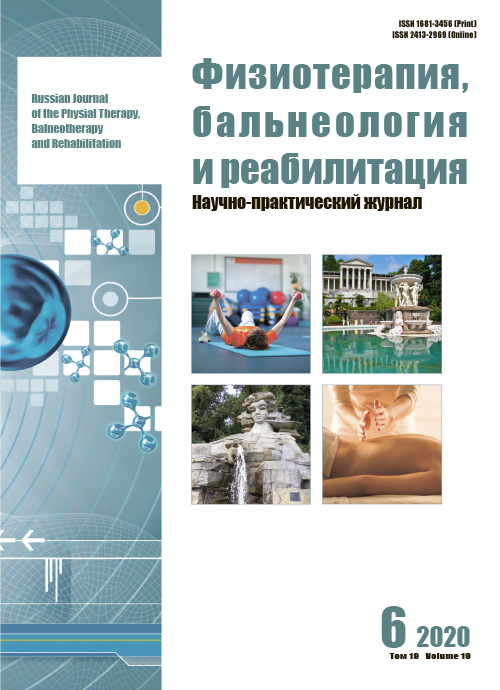Assessment of the dynamics of dermatologic index indicators of symptom scale and dermatologic quality of life index under the influence of complex phototherapy in patients with a combination of rosacea subtypes
- 作者: Novikov K.A.1, Tamrazova O.B.2, Matushevskaya Y.I.3
-
隶属关系:
- Clinic of active longevity "Institute of Beauty on the Arbat"
- Peoples' Friendship University of Russia
- Luberetskiy Dermatovenerologic Dispensary of the Ministry of Health of the Moscow region
- 期: 卷 19, 编号 6 (2020)
- 页面: 355-365
- 栏目: Original studies
- ##submission.datePublished##: 15.12.2020
- URL: https://rjpbr.com/1681-3456/article/view/78548
- DOI: https://doi.org/10.17816/1681-3456-2020-19-6-2
- ID: 78548
如何引用文章
详细
Background. Taking into account the data of recent studies on the treatment of rosacea, the development of new methods of treating this dermatosis using complex physiotherapeutic approaches and their synergism is of scientific and practical interest. In this work, we took into account the synergism of physiotherapeutic effects exerted by intense pulsed light and submilisecond neodymium 1064 nm laser radiation, as well as an increase in the destruction of pathologically altered vessels observed with the sequential use of both procedures.
Aims: to assess the effect of complex phototherapy on changes in the indicators of the dermatological index of the symptom scale and the dermatological index of quality of life, reflecting the effect of the therapy on the clinical manifestations of the disease and the patient's subjective assessment of the skin condition.
Material and methods. In the period 2017–2020 we conducted a randomized controlled study in which 130 patients with a combination of rosacea subtypes took part. All patients were divided into 4 groups. In each separate group, the following types of therapy were used: in group I — laser therapy and 1% metronidazole cream; in group II — phototherapy and 1% metronidazole cream; in group III — complex photo-laser therapy and 1% metronidazole cream; in the comparison group (IV), patients received only 1% metronidazole cream. The treatment included 6 sessions with an interval of 2 weeks, with a total duration of 3 months. The effectiveness of therapy was assessed according to the results of the dermatological index of quality of life (DQL) and the dermatological index of the symptom scale (DYS) before and after treatment.
Results. The developed complex method of combination of rosacea subtypes therapy demonstrated maximum efficiency, which was reflected in the maximum (by 55.21%) decrease in DYS in group III compared with the other three groups: in group I, the decrease in DYS was 30.54%, in II — 21.51%, in IV — 21.56%. The DQL in group III decreased by 67.4%, which was significantly higher than the indicators of the other three groups: in group I, DQL decreased by 31.3%, in group II — by 27.4%, in IV — by 20.7%.
Conclusion. After the course of complex phototherapy in the group of patients with combination of rosacea subtypes, there was a decrease in the severity of clinical manifestations of the disease, as well as an increase in the quality of life of patients according to the data of the DYS and DQL, respectively.
全文:
作者简介
Kirill Novikov
Clinic of active longevity "Institute of Beauty on the Arbat"
编辑信件的主要联系方式.
Email: dr.novikov.ka@mail.ru
ORCID iD: 0000-0002-8127-8113
俄罗斯联邦, Moscow
Olga Tamrazova
Peoples' Friendship University of Russia
Email: dr.novikov.ka@mail.ru
ORCID iD: 0000-0003-3261-6718
MD, Dr. Sci. (Med.), Professor
俄罗斯联邦, MoscowYuliya Matushevskaya
Luberetskiy Dermatovenerologic Dispensary of the Ministry of Health of the Moscow region
Email: dr.novikov.ka@mail.ru
ORCID iD: 0000-0001-5995-6689
MD, Cand. Sci. (Med.)
俄罗斯联邦, Lubertsy参考
- Steinhoff M, Schauber J, Leyden JJ. New insights into rosacea pathophysiology: a review of recent findings. J Am Acad Dermatol. 2013;69(6 Suppl 1):15–26. doi: 10.1016/j.jaad.2013.04.045
- Layton A, Thiboutot D. Emerging therapies in rosacea. J Am Acad Dermatol. 2013;69(6 Suppl 1):S57–S65. doi: 10.1016/j.jaad.2013.04.041
- Chang AL, Raber I, Xu J, et al. Assessment of the genetic basis of rosacea by genome-wide association study. J Investig Dermatol. 2015;135(6):1548–1555. doi: 10.1038/jid.2015.53
- Olisova OY, Egorova K. New developments in the pathogenesis and treatment of rosacea. Aesthetic medicine. 2015;(2):279–284. (In Russ).
- Rosso JA. A status report on the medical management of rosacea: focus on topical therapies. Cutis. 2002;70(5):271–275.
- McAleer MA, Fitzpatrick P, Powell FC. Papulopustular rosacea: prevalence and relationship to photodamage. J Am Acad Dermatol. 2010;63(1):33–39. doi: 10.1016/j.jaad.2009.04.024
- Berg M, Liden S. An epidemiological study of rosacea. Acta Derm Venereal. 1989;69(5):419–423.
- Millikan L. Rosacea as an inflammatory disorder: A uniying theory? Cutis. 2004;73(Suppl 1):5–8.
- Kruglova LS, Kotenko KV, Korchazhkina NB, Turbovskaya SN. Physiotherapy in dermatology. Moscow: GEOTAR-Media; 2016. Р. 1–9. (In Russ).
补充文件















